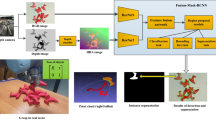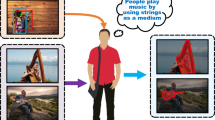Abstract
Object affordance detection aims to identify, locate and segment the functional regions of objects, so that robots can understand and manipulate objects like humans. The affordance detection task has two main challenges: (1) Due to the need to provide accurate positioning information for the robot to manipulate objects, the affordance segmentation results are required to have high boundary quality. (2) Different kinds of objects have significant differences in appearances, but may have the same affordance. Correspondingly, parts with the same appearance may have different affordances. The existing methods regard affordance detection as an image segmentation problem, without focusing on the boundary quality of detection results. In addition, most of the existing methods do not consider the potential relationship between object categories and object affordances. Aiming at the above problems, we propose a boundary-preserving network (BPN) to provide affordance masks with better boundary quality for robots to manipulate objects. Our framework contains three new components: the IoU (Intersection-over-Union) branch, the affordance boundary branch and the relationship attention module. The IoU branch is used to predict the IoU score of each object bounding box. The affordance boundary branch is used to guide the network to learn the boundary features of objects. The relationship attention module is used to enhance the feature representation capability of the network by exploring the potential relationship between object categories and object affordances. Experiments show that our method is helpful to improve the boundary quality of the predicted affordance masks. On the IIT-AFF dataset, the performance of the proposed BPN is 2.32% (F-score) and 2.89% (F-score) higher than that of the strong baseline in terms of affordance masks and the boundaries of affordance masks, respectively. Furthermore, the real-world robot manipulation experiments show that the proposed BPN can provide accurate affordance information for robots to manipulate objects.












Similar content being viewed by others
Data availability
The public IIT-AFF dataset is used in this project.
Code availability
The project is not complete yet, and we will release some of the source code when the project is complete.
References
Gibson JJ (2014) The ecological approach to visual perception, classic. Psychology Press, Hove
Ferretti, G.: A distinction concerning vision-for-action and affordance perception. Consciousness and Cognition 87 (2021). doi:https://doi.org/10.1016/j.concog.2020.103028
Hassanin M, Khan S, Tahtali M (2021) Visual affordance and function understanding: a survey. Acm Comput Surv. https://doi.org/10.1145/3446370
Do TT, Nguyen A, Reid I (2018) AffordanceNet: an end-to-end deep learning approach for object affordance detection. In: 2018 IEEE international conference on robotics and automation (ICRA), 21–25 May 2018, pp 5882–5889
Chu F, Xu R, Vela PA (2019) Learning affordance segmentation for real-world robotic manipulation via synthetic images. IEEE Robot Autom Lett 4(2):1140–1147. https://doi.org/10.1109/LRA.2019.2894439
Minh CND, Gilani SZ, Islam SMS, Suter D (2020) Learning affordance segmentation: an investigative study. In: 2020 digital image computing: techniques and applications (DICTA), 29 Nov.–2 Dec. 2020, pp 1–8
Zhao X, Cao Y, Kang Y (2020) Object affordance detection with relationship-aware network. Neural Comput Appl 32(18):14321–14333. https://doi.org/10.1007/s00521-019-04336-0
Gu QP, Su JH, Yuan L (2021) Visual affordance detection using an efficient attention convolutional neural network. Neurocomputing 440:36–44. https://doi.org/10.1016/j.neucom.2021.01.018
Chen X, Lian Y, Jiao L, Wang H, Gao Y, Lingling S (2020) Supervised edge attention network for accurate image instance segmentation. In: Vedaldi A, Bischof H, Brox T, Frahm J-M (eds) Computer vision: ECCV 2020, 2020, pp. 617–631. Springer International Publishing, Cham
He K, Gkioxari G, Dollár P, Girshick R (2020) Mask R-CNN. IEEE Trans Pattern Anal Mach Intell 42(2):386–397. https://doi.org/10.1109/TPAMI.2018.2844175
Ren S, He K, Girshick R, Sun J (2017) Faster R-CNN: towards real-time object detection with region proposal networks. IEEE Trans Pattern Anal Mach Intell 39(6):1137–1149. https://doi.org/10.1109/TPAMI.2016.2577031
Cai Z, Vasconcelos N (2018) Cascade R-CNN: delving into high quality object detection. In: 2018 IEEE/CVF conference on computer vision and pattern recognition (CVPR), 18–23 June 2018, pp 6154–6162
Wu Y, Chen Y, Yuan L, Liu Z, Wang L, Li H, Fu Y (2020) Rethinking classification and localization for object detection. In: 2020 IEEE/CVF conference on computer vision and pattern recognition (CVPR), 13–19 June 2020, pp 10183–10192
Jiang B, Luo R, Mao J, Xiao T, Jiang Y (2018) Acquisition of localization confidence for accurate object detection. In: Computer vision: ECCV 2018, pp 816–832. Springer International Publishing, Cham
Chi C, Zeng X, Bruniaux P, Tartare G (2021) A study on segmentation and refinement of key human body parts by integrating manual measurements. Ergonomics. https://doi.org/10.1080/00140139.2021.1963489
Ruiz E, Mayol-Cuevas W (2020) Geometric affordance perception: leveraging deep 3D saliency with the interaction tensor. Front Neurorobot. https://doi.org/10.3389/fnbot.2020.00045
Qian K, Jing XS, Duan YH, Zhou B, Fang F, Xia J, Ma XD (2020) Grasp pose detection with affordance-based task constraint learning in single-view point clouds. J Intell Rob Syst 100(1):145–163. https://doi.org/10.1007/s10846-020-01202-3
Corona E, Pumarola A, Alenyà G, Moreno-Noguer F, Rogez G (2020) GanHand: predicting human grasp affordances in multi-object scenes. In: 2020 IEEE/CVF conference on computer vision and pattern recognition (CVPR), 13–19 June 2020, pp. 5030–5040
Montesano L, Lopes M, Bernardino A, Santos-Victor J (2008) Learning object affordances: from sensory-motor coordination to imitation. IEEE Trans Rob 24(1):15–26. https://doi.org/10.1109/TRO.2007.914848
Chang O (2015) A bio-inspired robot with visual perception of affordances. In: Agapito L, Bronstein MM, Rother C (eds) Computer vision: ECCV 2014 workshops, pp 420–426. Springer International Publishing, Cham
Song HO, Fritz M, Goehring D, Darrell T (2016) Learning to detect visual grasp affordance. IEEE Trans Autom Sci Eng 13(2):798–809. https://doi.org/10.1109/TASE.2015.2396014
Myers A, Teo CL, Fermüller C, Aloimonos Y (2015) Affordance detection of tool parts from geometric features. In: 2015 IEEE international conference on robotics and automation (ICRA), 26–30 May 2015, pp 1374–1381
Lakani SR, Rodríguez-Sánchez AJ, Piater J (2017) Can affordances guide object decomposition into semantically meaningful parts? In: 2017 IEEE winter conference on applications of computer vision (WACV), 24–31 March 2017, pp 82–90
Lakani SR, Rodríguez-Sánchez AJ, Piater J (2018) Exercising affordances of objects: a part-based approach. IEEE Robot Autom Lett 3(4):3465–3472. https://doi.org/10.1109/LRA.2018.2853639
Rezapour Lakani S, Rodríguez-Sánchez AJ, Piater J (2019) Towards affordance detection for robot manipulation using affordance for parts and parts for affordance. Auton Robot 43(5):1155–1172. https://doi.org/10.1007/s10514-018-9787-5
Iizuka M, Hashimoto M (2018) Detection of semantic grasping-parameter using part-affordance recognition. In: 2018 19th International conference on research and education in mechatronics (REM), 7–8 June 2018, pp 136–140
Iizuka M, Akizuki S, Hashimoto M (2019) Accuracy improvement of functional attribute recognition by dense CRF considering object shape. Electron Commun Jpn 102(3):56–62. https://doi.org/10.1002/ecj.12151
He K, Zhang X, Ren S, Sun J (2016) Deep residual learning for image recognition. In: 2016 IEEE conference on computer vision and pattern recognition (CVPR), 27–30 June 2016, pp 770–778
Huang G, Liu Z, Maaten LVD, Weinberger KQ (2017) Densely connected convolutional networks. In: 2017 IEEE conference on computer vision and pattern recognition (CVPR), 21–26 July 2017, pp 2261–2269
Hu J, Shen L, Sun G (2018) Squeeze-and-excitation networks. In: 2018 IEEE/CVF conference on computer vision and pattern recognition, 18–23 June 2018, pp 7132–7141
Tan M, Le Q (2019) Efficientnet: rethinking model scaling for convolutional neural networks. In: International conference on machine learning 2019, pp 6105–6114. PMLR
Zhang H, Wu C, Zhang Z, Zhu Y, Lin H, Zhang Z, Sun Y, He T, Mueller J, Manmatha RJ (2020) Resnest: split-attention networks. arXiv preprint arXiv:2004.08955 (2020)
Ardón P, Pairet È, Lohan KS, Ramamoorthy S, Petrick RJ (2020) Affordances in robotic tasks--a survey. arXiv:2004.07400
Lenz I, Lee H, Saxena A (2015) Deep learning for detecting robotic grasps. Int J Robot Res 34(4–5):705–724. https://doi.org/10.1177/0278364914549607
Redmon J, Angelova A (2015) Real-time grasp detection using convolutional neural networks. In: 2015 IEEE international conference on robotics and automation (ICRA), 26–30 May 2015, pp 1316–1322
Guo D, Sun F, Liu H, Kong T, Fang B, Xi N (2017) A hybrid deep architecture for robotic grasp detection. In: 2017 IEEE international conference on robotics and automation (ICRA), 29 May–3 June 2017, pp 1609–1614
Chu F, Xu R, Vela PA (2018) Real-world multiobject, multigrasp detection. IEEE Robot Autom Lett 3(4):3355–3362. https://doi.org/10.1109/LRA.2018.2852777
Watson J, Hughes J, Iida F (2017) Real-world, real-time robotic grasping with convolutional neural networks. In: Towards autonomous robotic systems, pp 617–626. Springer International Publishing, Cham
Ardón PÈP, Petillot Y, Petrick RPA, Ramamoorthy S, Lohan KS (2021) Self-assessment of grasp affordance transfer. In: 2020 IEEE/RSJ international conference on intelligent robots and systems (IROS), 24 Oct.–24 Jan. 2021, pp 9385–9392
Nguyen A, Kanoulas D, Caldwell DG, Tsagarakis NG (2016) Detecting object affordances with convolutional neural networks. In: 2016 IEEE/RSJ international conference on intelligent robots and systems (IROS), 9–14 Oct. 2016, pp. 2765–2770
Nguyen A, Kanoulas D, Caldwell DG, Tsagarakis NG (2017) Object-based affordances detection with convolutional neural networks and dense conditional random fields. In: 2017 IEEE/RSJ international conference on intelligent robots and systems (IROS), 24–28 Sept. 2017, pp. 5908–5915
Chu FJ, Xu R, Seguin L, Vela PA (2019) Toward affordance detection and ranking on novel objects for real-world robotic manipulation. IEEE Robot Autom Lett 4(4):4070–4077. https://doi.org/10.1109/LRA.2019.2930364
Yin C, Zhang Q, Ren W (2021) A new semantic edge aware network for object affordance detection. J Intell Rob Syst 104(1):2. https://doi.org/10.1007/s10846-021-01525-9
Simonyan K, Zisserman A (2015) Very deep convolutional networks for large-scale image recognition. In: 3rd international conference on learning representations (ICLR 2015), 7–9 May 2015, pp 1–14
Lin T, Dollár P, Girshick R, He K, Hariharan B, Belongie S (2017) Feature pyramid networks for object detection. In: 2017 IEEE conference on computer vision and pattern recognition (CVPR), 21–26 July 2017, pp 936–944
Fu J, Liu J, Tian H, Li Y, Bao Y, Fang Z, Lu H (2019) Dual attention network for scene segmentation. In: 2019 IEEE/CVF conference on computer vision and pattern recognition (CVPR), 15–20 June 2019, pp 3141–3149
Zheng Z, Wang P, Liu W, Li J, Ye R, Ren D (2020) Distance-IoU loss: faster and better learning for bounding box regression. Proc AAAI Conf Artif Intell 34(07):12993–13000. https://doi.org/10.1609/aaai.v34i07.6999
Cheng T, Wang X, Huang L, Liu W (2020) Boundary-preserving mask R-CNN. In: Vedaldi A, Bischof H, Brox T, Frahm J-M (eds) Computer vision: ECCV 2020. Springer, Cham, pp 660–676
Zhen M, Wang J, Zhou L, Li S, Shen T, Shang J, Fang T, Quan L (2020) Joint semantic segmentation and boundary detection using iterative pyramid contexts. In: 2020 IEEE/CVF conference on computer vision and pattern recognition (CVPR), 13–19 June 2020, pp. 13663–13672
Casas S, Gulino C, Suo S, Urtasun R (2020) The importance of prior knowledge in precise multimodal prediction. In: 2020 IEEE/RSJ international conference on intelligent robots and systems (IROS), 24 Oct.–24 Jan. 2021, pp 2295–2302
Woo S, Park J, Lee J-Y, Kweon IS (2018) CBAM: convolutional block attention module. In: Ferrari V, Hebert M, Sminchisescu C, Weiss Y (eds) Computer vision: ECCV 2018. Springer International Publishing, Cham, pp 3–19
Selvaraju RR, Cogswell M, Das A, Vedantam R, Parikh D, Batra D (2017) Grad-CAM: visual explanations from deep networks via gradient-based localization. In: 2017 IEEE international conference on computer vision (ICCV), 22–29 Oct. 2017, pp. 618–626
Funding
No funding was received for conducting this study.
Author information
Authors and Affiliations
Contributions
CY is responsible for the main research work and paper writing. QZ is responsible for the guidance of the project.
Corresponding author
Ethics declarations
Conflicts of interest
The authors declare that they have no conflicts of interest to this work.
Ethics approval
Not applicable.
Consent to participate
Not applicable.
Consent for publication
All authors have read this manuscript and would like to have it considered exclusively for publication in neural computing and applications.
Additional information
Publisher's Note
Springer Nature remains neutral with regard to jurisdictional claims in published maps and institutional affiliations.
Rights and permissions
About this article
Cite this article
Yin, C., Zhang, Q. Object affordance detection with boundary-preserving network for robotic manipulation tasks. Neural Comput & Applic 34, 17963–17980 (2022). https://doi.org/10.1007/s00521-022-07446-4
Received:
Accepted:
Published:
Issue Date:
DOI: https://doi.org/10.1007/s00521-022-07446-4




